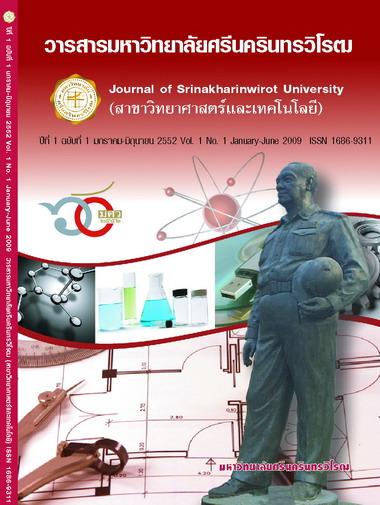อิทธิพลของความล้าต่อการยึดติดระหว่างวัสดุบูรณะฟันเซรามิกชนิดเฟลสปาติกและผิวเคลือบฟันธรรมชาติของมนุษย์ (THE INFLUENCE OF FATIGUE IN RESIN-BONDED CERAMIC/ENAMEL BONDS)
Keywords:
Fatigue resistance, Bonding, Ceramic, Adhesion, FractographyAbstract
บทคัดย่อ วัสดุบูรณะฟันหลายชนิดที่นิยมแพร่หลายในปัจจุบันรวมถึงวัสดุบูรณะฟันเซรามิกชนิดเฟลสปาติก (Feldspathic porcelain) ถูกนำมายึดติดกับเคลือบฟันหรือเนื้อฟันด้วยสารยึดติดชนิดเมตาคริลเลตเรซินและคอมโพสิต วัสดุบูรณะฟันเหล่านี้ได้รับแรงบดเคี้ยวซึ่งเป็นแรงกระทำซ้ำๆ และอาจมีค่าสูงถึง 800 นิวตัน ก่อให้เกิดความล้าในตัววัสดุบูรณะ และส่งผลต่อการยึดติดระหว่างวัสดุบูรณะและเคลือบฟันหรือเนื้อฟัน วัตถุประสงค์หลักของงานวิจัยนี้คือศึกษาอิทธิพลของความล้าต่อการยึดติดระหว่างเซรามิกชนิดเฟลสปาติกและผิวเคลือบฟันธรรมชาติของมนุษย์ โดยทำการทดสอบความต้านทานต่อความล้า (Fatigue resistance) ของชิ้นทดสอบ และทำการศึกษาวิเคราะห์การแตกหักและความเสียหายที่เกิดขึ้นกับชิ้นทดสอบโดยใช้กล้องจุลทรรศน์อิเลคตรอนชนิดส่องกราด (Scanning electron microscope) และกล้องจุลทรรศน์ชนิด Incident light microscope ในชิ้นทดสอบที่ผ่านการย้อมสีด้วยซิลเวอร์ไนเตรท (AgNO3) เซรามิก จำนวน 61 ชิ้น ถูกสร้างขึ้นด้วยกระบวนการเผาหลอมผงเซรามิก 1 ในเบ้าทนไฟทรงกระบอกขนาดเส้นผ่านศูนย์กลาง 5 มิลลิเมตร สูง 4 มิลลิเมตร เซรามิก 10 ชิ้น ถูกนำไปทดสอบหาค่าความแข็งแรงเฉือนด้วยเครื่อง Universal Testing Machine สำหรับชิ้นเซรามิกที่เหลือผิวด้านหนึ่งของชิ้นเซรามิกถูกเป่าทราย กัดด้วยกรดไฮโดรฟลูออริก 9.5% เป็นเวลา 15 นาที และได้รับการปรับสภาพผิวด้วยสารไซเลนไพรเมอร์ ชิ้นเซรามิกถูกแบ่งเป็น 3 กลุ่ม กลุ่มละ 17 ชื้น โดยการสุ่มฟันกรามใหญ่ของมนุษย์ 51 ซี่ ซึ่งถูกถอนและเก็บไว้ในสารละลายไทมอลเป็นระยะเวลาไม่เกิน 3 เดือน ผิวเคลือบฟันด้านหนึ่งได้รับการกัดด้วยกรดฟอสฟอริก 37.5% เป็นเวลา 30 วินาที ล้างและเป่าแห้ง ชิ้นเซรามิกถูกยึดติดกับผิวเคลือบฟันมนุษย์โดยใช้สารยึดติดชนิดเรซิน 3 ระบบ คือ Calibra2, Nexus3 และ Panavia4 ชิ้นทดสอบถูกนำไปทดสอบความต้านทานต่อความล้าในเครื่องทดสอบความล้า (Fatigue testing machine) โดยใช้วิธีการทดสอบแบบขั้นบันได (Staircase method) กำหนดจำนวนรอบคงที่ ที่ 5000 รอบ และอัตราเร็วของการทดสอบ 80 รอบต่อนาที ชิ้นทดสอบที่แตกหักระหว่างการทดลองถูกนำไปศึกษาด้วยกล้องจุลทรรศน์อิเลคตรอนชนิดส่องกราด ส่วนชิ้นทดสอบซึ่งไม่แตกหักถูกนำไปย้อมด้วยสารประกอบซิลเวอร์ไนเตรท และได้รับการตัดแต่งเพื่อศึกษาด้วยกล้องจุลทรรศน์ชนิด Incident light microscope ผลการทดสอบความต้านทานต่อความล้าคือ Calibra 13.74+ 0.1 MPa, Nexus 11.41 + 1.44 MPa, Panavia 12.28 + 2.66 MPa ผลจากการศึกษาด้วยกล้องจุลทรรศน์ ในทุกกลุ่มทดลองสามารถพบรอยแตกร้าว (crack) ซึ่งเกิดจากความล้าของวัสดุ โดยรอยแตกร้าวนี้เริ่มเกิดในชิ้นเซรามิกหรือเกิดบริเวณรอยต่อระหว่างชิ้นเซรามิกและผิวเคลือบฟัน รอยแตกร้าวดำเนินผ่านชั้นวัสดุคอมโพสิตแต่ไม่ทำให้ผิวเคลือบฟันแตก การย้อมสีด้วยซิลเวอร์ไนเตรทพบว่ามีความเสียหายและรอยร้าวเกิดขึ้นในวัสดุเซรามิกและมีการรั่วซึมบริเวณรอยต่อระหว่างเซรามิกและเรซินคอมโพสิต งานวิจัยนี้พบว่าชิ้นทดสอบแตกหักในลักษณะผสมคือมีการแตกหักทั้งในตัววัสดุและในบริเวณรอยต่อของวัสดุและสารยึดติด การย้อมสีชิ้นทดสอบแสดงให้เห็นว่ามีความเสียหายเกิดขึ้นในชิ้นเซรามิกก่อนเกิดการแตกหัก แสดงว่าความอ่อนแอของวัสดุเซรามิกเป็นสาเหตุสำคัญที่ส่งผลต่อการแตกหักของชิ้นทดสอบ
Many modern dental restorations including feldspatic ceramic are bonded to tooth surface by metacrylate resins and composites. These restorations are usually subjected to cyclic masticatory forces with peak loads of 800N. In this study, resin-bonded ceramic specimens were subjected to cyclic loading. Fracture and damage were studied using SEM and incident light microscopy was used to investigate specimens stained with AgNO3. Sixty-one ceramic cylinders (Φ=5mmx4 mm) were fabricated by sintering porcelain powder. 1 Ten ceramic cylinders were tested in the Universal Testing Machine for shear strength. The rest of ceramic cylinders were sandblasted and etched with 9.5% hydrofluoric acid for 15 minutes. The ceramic surface was treated with a primer (silane) and randomly divided into 3 groups of 17. Each group was treated with one of three resin cement systems2-4 (Calibra, Nexus, Panavia). The enamel of 51 extracted teeth those were kept in thymol solution no more than 3 months was etched with 37.5% phosphoric acid for 30 seconds and the resin applied. The well prepared cylinders were then attached and bonded to the enamel surface. The specimen was held in a fatigue testing machine and subjected to a “staircase” fatigue test using 5000 cycles at 80 cycles/ min. The fracture surfaces of the failed specimens were examined in a SEM. Other non-fractured samples were stained with AgNO3 and prepared for incident light microscopy. The fatigue limit results were Calibra 13.74 + 0.1 MPa, Nexus 11.41 + 1.44 MPa, Panavia 12.28 + 2.66 MPa. In all systems, the fatigue crack initiated at either the ceramic or the ceramic/resin interface. The crack propagated through the bonding composite and did not fracture the underlying tooth. Staining indicated damage in the ceramic and leakage along the ceramic resin interface. In this study, the specimens failed by mixed mode fracture. Staining indicated that there was ceramic damage prior to failure. It was shown that the weakness of ceramic was the important factor causes specimen fracture. 1 Vitadur, Vivadent, 2 Calibra with Prime and Bond resin, Dentsply, 3 Nexus with Optibond resin, Kerr, 4 Panavia with Clearfil SE Bond resin, Kuraray.
Downloads
Downloads
Published
How to Cite
Issue
Section
License
Srinakharinwirot University Journal of Sciences and Technology is licensed Under a Creative Commons Attribution-NonCommercial-NoDerivs 4.0 International (CC-BY-NC-ND 4.0) License, Unless Otherwise Stated. Please Read Journal Policies Page for More Information on Open Access, Copyright and Permissions.



